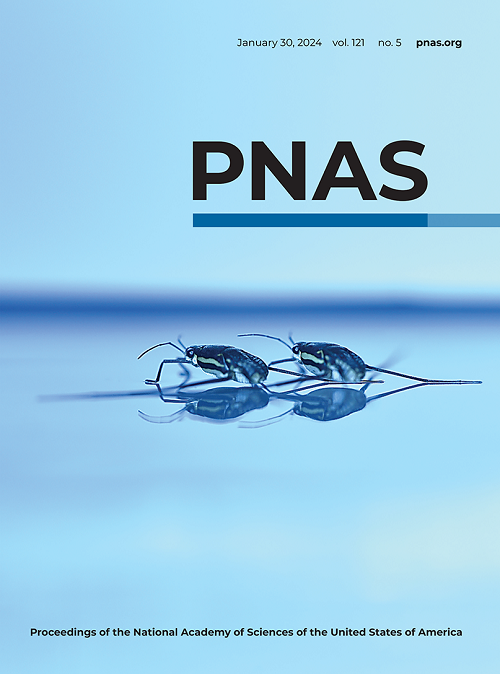MFRP is a molecular hub that organizes the apical membrane of RPE cells by engaging in interactions with specific proteins and lipids
IF 9.4
1区 综合性期刊
Q1 MULTIDISCIPLINARY SCIENCES
Proceedings of the National Academy of Sciences of the United States of America
Pub Date : 2025-04-18
DOI:10.1073/pnas.2425523122
引用次数: 0
Abstract
Membrane frizzled-related protein (MFRP), present in the retinal pigment epithelium (RPE), is an integral membrane protein essential for ocular development and the normal physiology of the retina. Mutations in MFRP are associated with autosomal recessive nonsyndromic nanophthalmos, leading to severe hyperopia and early-onset retinitis pigmentosa. While several preclinical gene-augmentation and gene-editing trials hold promise for future therapies aimed at stopping degeneration and restoring retinal function, the molecular mechanisms involved in MFRP biology are still not well understood. Here, we studied the biochemical properties of MFRP and the molecular consequences of its loss of function in the retinal degeneration 6 (rd6) mouse model. Using transcriptomic and lipidomic approaches, we observed that accumulation of docosahexaenoic acid (DHA) constitutes a primary defect in the MFRP-deficient RPE. In biochemical assays, we showed that MFRP undergoes extensive glycosylation, and it preferentially binds lipids of several classes, including phosphatidylserine and phosphatidylinositol-4-phosphate; as well as binding to several transmembrane proteins, notably adiponectin receptor 1 (ADIPOR1) and inward rectifier potassium channel 13 (KCNJ13). Moreover, MFRP determines the subcellular localization of ADIPOR1 and KCNJ13 in the RPE in vivo. This feature is altered by MFRP deficiency and can be restored by gene-therapy approaches. Overall, our observations suggest that MFRP constitutes an important interaction hub within the apical membrane of RPE cells, coordinating protein trafficking and subcellular localization within the RPE, and lipid homeostasis within the entire retina.MFRP是一个分子中枢,通过与特定蛋白质和脂质相互作用来组织RPE细胞的顶膜
膜卷曲相关蛋白(MFRP)存在于视网膜色素上皮(RPE)中,是眼部发育和视网膜正常生理所必需的一种完整的膜蛋白。MFRP突变与常染色体隐性非综合征性纳米眼相关,可导致严重远视和早发性视网膜色素变性。虽然一些临床前基因增强和基因编辑试验为未来旨在阻止变性和恢复视网膜功能的治疗带来了希望,但MFRP生物学中涉及的分子机制仍未得到很好的理解。在这里,我们研究了MFRP的生化特性及其在视网膜变性6 (rd6)小鼠模型中功能丧失的分子后果。利用转录组学和脂质组学方法,我们观察到二十二碳六烯酸(DHA)的积累构成了mfrp缺陷RPE的主要缺陷。在生化分析中,我们发现MFRP经历了广泛的糖基化,它优先结合几种类型的脂质,包括磷脂酰丝氨酸和磷脂酰肌醇-4-磷酸;并结合几种跨膜蛋白,特别是脂联素受体1 (ADIPOR1)和内向整流钾通道13 (KCNJ13)。此外,MFRP还决定了ADIPOR1和KCNJ13在体内RPE中的亚细胞定位。这一特征会因MFRP缺乏而改变,并可通过基因治疗方法恢复。总的来说,我们的观察结果表明,MFRP构成了RPE细胞顶膜内重要的相互作用枢纽,协调RPE内的蛋白质运输和亚细胞定位,以及整个视网膜内的脂质稳态。
本文章由计算机程序翻译,如有差异,请以英文原文为准。
求助全文
约1分钟内获得全文
求助全文
来源期刊
CiteScore
19.00
自引率
0.90%
发文量
3575
审稿时长
2.5 months
期刊介绍:
The Proceedings of the National Academy of Sciences (PNAS), a peer-reviewed journal of the National Academy of Sciences (NAS), serves as an authoritative source for high-impact, original research across the biological, physical, and social sciences. With a global scope, the journal welcomes submissions from researchers worldwide, making it an inclusive platform for advancing scientific knowledge.

 求助内容:
求助内容: 应助结果提醒方式:
应助结果提醒方式:


